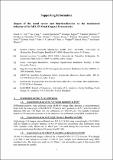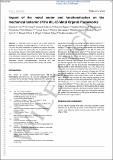Files in this item
Impact of the metal centre and functionalization on the mechanical behaviour of MIL-53 metal–organic frameworks
Item metadata
| dc.contributor.author | Yot, Pascal G. | |
| dc.contributor.author | Yang, Ke | |
| dc.contributor.author | Guillerm, Vincent | |
| dc.contributor.author | Ragon, Florence | |
| dc.contributor.author | Dmitriev, Vladimir | |
| dc.contributor.author | Parisiades, Paraskevas | |
| dc.contributor.author | Elkaïm, Erik | |
| dc.contributor.author | Devic, Thomas | |
| dc.contributor.author | Horcajada, Patricia | |
| dc.contributor.author | Serre, Christian | |
| dc.contributor.author | Stock, Norbert | |
| dc.contributor.author | Mowat, John P. S. | |
| dc.contributor.author | Wright, Paul A. | |
| dc.contributor.author | Férey, Gérard | |
| dc.contributor.author | Maurin, Guillaume | |
| dc.date.accessioned | 2017-07-04T23:33:42Z | |
| dc.date.available | 2017-07-04T23:33:42Z | |
| dc.date.issued | 2016-09-27 | |
| dc.identifier | 244261754 | |
| dc.identifier | 4004c2ef-bc48-4a24-81c4-8ac74cd12263 | |
| dc.identifier | 84978148590 | |
| dc.identifier | 000386166900023 | |
| dc.identifier.citation | Yot , P G , Yang , K , Guillerm , V , Ragon , F , Dmitriev , V , Parisiades , P , Elkaïm , E , Devic , T , Horcajada , P , Serre , C , Stock , N , Mowat , J P S , Wright , P A , Férey , G & Maurin , G 2016 , ' Impact of the metal centre and functionalization on the mechanical behaviour of MIL-53 metal–organic frameworks ' , European Journal of Inorganic Chemistry , vol. 2016 , no. 27 , pp. 4424–4429 . https://doi.org/10.1002/ejic.201600263 | en |
| dc.identifier.issn | 1099-0682 | |
| dc.identifier.other | Bibtex: urn:3d51d38e56788d829431da158a37ab2e | |
| dc.identifier.other | ORCID: /0000-0002-4243-9957/work/62668304 | |
| dc.identifier.uri | https://hdl.handle.net/10023/11147 | |
| dc.description | The French National Agency for Research ANR “MODS” (ANR-12-BS10-0005) is thanked for its financial support. | en |
| dc.description.abstract | An extended series of MIL-53(M)_X metal–organic frameworks (MIL = Materials of Institute Lavoisier; M = Al, Cr, Fe, Sc; X = Cl, CH3, NO2) have been systematically investiaged to explore the impact of the nature of both the metal centre and the functions grafted on to the organic linker on the mechanical behaviour of this family of highly flexible hybrid porous frameworks under the application of an external pressure of up to 3 GPa. The high-pressure X-ray diffraction measurements allowed the characterization of the pressure-induced phase transitions of the hydrated structures, the associated volume changes/pressure transitions, and their mechanical resilience through the determination of their bulk moduli. | |
| dc.format.extent | 6 | |
| dc.format.extent | 1157082 | |
| dc.format.extent | 850035 | |
| dc.language.iso | eng | |
| dc.relation.ispartof | European Journal of Inorganic Chemistry | en |
| dc.subject | Metal–organic frameworks | en |
| dc.subject | Mechanical properties | en |
| dc.subject | X-ray diffraction | en |
| dc.subject | Phase transitions | en |
| dc.subject | Substituent effects | en |
| dc.subject | QD Chemistry | en |
| dc.subject | NDAS | en |
| dc.subject.lcc | QD | en |
| dc.title | Impact of the metal centre and functionalization on the mechanical behaviour of MIL-53 metal–organic frameworks | en |
| dc.type | Journal article | en |
| dc.contributor.institution | University of St Andrews. School of Chemistry | en |
| dc.contributor.institution | University of St Andrews. EaSTCHEM | en |
| dc.identifier.doi | https://doi.org/10.1002/ejic.201600263 | |
| dc.description.status | Peer reviewed | en |
| dc.date.embargoedUntil | 2017-07-04 | |
| dc.identifier.url | http://onlinelibrary.wiley.com/doi/10.1002/ejic.201600263/abstract#footer-support-info | en |
This item appears in the following Collection(s)
Items in the St Andrews Research Repository are protected by copyright, with all rights reserved, unless otherwise indicated.


